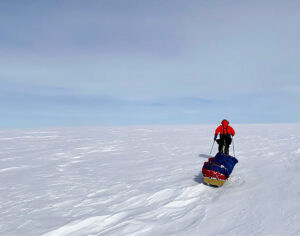In Part II of our guide to 2018-2019 Antarctic expeditions, another challenger joins the race to claim the first solo, unsupported, unassisted crossing, and a Japanese rickshaw driver attempts to retrace the steps of the classic 1910 Japanese Antarctic Expedition.
Colin O’Brady – The Impossible First

Colin O’Brady has previously completed last-degree expeditions to both the North and South Poles. Photo: Colin O’Brady
Endurance athlete Colin O’Brady will fly to Antarctica shortly to target what he calls “the impossible first”, a solo, unsupported, unassisted crossing from the edge of the Ronne Ice Shelf to the start of the Ross Ice Shelf via the South Pole.

O’Brady’s traverse will not include either the Ronne or Ross Ice Shelves. Photo: Colin O’Brady
The former record holder for the fastest Explorer’s Grand Slam (the version with last-degree polar expeditions), O’Brady will race Britain’s Lou Rudd if he wishes to claim the record. Like Rudd, he will try to complete the crossing in roughly 70 days. His sled and gear, listed at 180kg on his website, weighs some 30kg more than Rudd’s. If neither makes it, Barry Gray hopes to accomplish the feat next season.
Masatatsu Abe – Solo via the Messner Route

Masatatsu Abe recently spent 220 days pulling a rickshaw across Japan. Photo: Masatatsu Abe
Masatatsu Abe has been preparing since 2014 for a solo, unassisted, unsupported manhaul to the South Pole.
The rickshaw driver wishes to pay homage to Nobu Shirase and the Japanese expedition that landed on King Edward VII Land, Antarctica in 1910. That expedition never made it to the South Pole. Instead, they explored the coast around the eastern part of the Ross Ice Shelf. Abe plans to retrace their steps in 2019, but will train for this by taking Reinhold Messner and Arved Fuchs’ 1989 route via the Ronne Ice Shelf to the Pole this year. He’ll haul a 100kg sled and plans to walk for over 10 hours a day.

Abe’s proposed route. Photo: Masatatsu Abe
Joe Doherty – Messner to South Pole with Kite return to Hercules Inlet

Joe Doherty. Photo: Joe Doherty.
Joe Doherty is an outdoor instructor and scout from the UK. Doherty will ski solo and unassisted from the Messner Start to the South Pole in around 50 days and then return to Hercules Inlet by kite-ski. He aims to complete the 1,900 km journey in 70 days.
You can check out Part I of our 2018-2019 Antarctica guide here.






